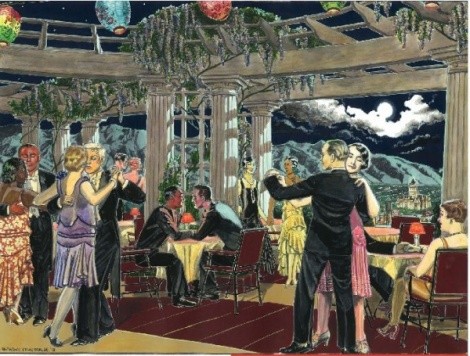
There have been a number of demonstrations since, but it perhaps took someone from outside the local community to organize a response from local artists. Now that Laura Sharp Wilson has organized “The PDA Show” (Public Display of Affection) at various locations downtown, it seems not only inevitable, but something the artistic community desperately needed, to have a forum to present their perspectives prompted by the subject.
Wilson moved here in May 2009 from Olympia, Wash., when her husband got a job with the U.S. Forest Service. Wilson, a painter herself, was looking for a way to get a foot in the local art scene. When she heard about the July 9 incident, it spurred her to action and gave her the idea for the show. Originally, she just sent out invitations to artists she knew who might be sympathetic, including people she had met in graduate school at UNC-Chapel Hill and as an undergraduate at Carnegie Mellon in New York.
But as often happens in cases like this, her call for entries “just kind of got around.”
Initially, she had planned to house the exhibit at one space, but when Kayo Gallery’s Davina Pallone, Jay Heuman of the Salt Lake Art Center and Joe Evans of NoBrow Coffee showed interest, she decided it was fitting to show works at multiple locations, in solidarity with the “we are everywhere” sentiment of gay activists. “Utah’s LGBTs and allies have a responsibility to express our stand for equality at every opportunity,” Pallone adds.
Alchemy Coffee and the Utah Pride Center will show framed works on canvas. NoBrow Coffee will hang works on paper—including photos—salon-style, floor to ceiling. At Ken Sanders Rare Books, the wall just past the entryway will display a poster of Nestor Armando Gil’s installation of school desk and pencils, paying homage to California secondary student Lawrence King, murdered in 2008 by a classmate after admitting to being gay.
The opening will include music and poetry performances at NoBrow and a kissing booth at Kayo Gallery. Working the booth will be members of Wasatch Roller Derby, local musicians Band of Annuals, several board members of the Utah Pride Center, the fund-raising group Utah Cyber Sluts and, most notably, Sister Dottie S. Dixon.
Photographer Russel A. Daniels, a Salt Lake City expat living in San Francisco, contributed vivid color prints he took at the 2004 and 2005 LDS General Conferences. They’re sharp visual testimonies of PDAs committed by the faithful: an elderly couple holding hands, a young couple leaning in for a kiss while picnicking on the lawn.
Michael Leese of Richmond, Va., took perhaps the most unexpected interpretation of the theme, submitting two images from his “Reading Blues” series of pictures from obituaries. The painting “The Law is for Protection of the People,” by Nick Davis of Alabama, uses the nail symbolism from the title of the Colbert segment, “Nailed ’Em.”
Adrian Herman of Portland, Maine, created a set of postage stamps depicting a same-sex couple atop a wedding cake. Irene Stapleford’s collage “Where Do We Draw the Line?” includes images from water safety and swimming instruction manuals to suggest that any public physical contact can be potentially intimate.
Wilson has received artwork for the show from contributors as widespread as Lorena Endara and Jose Manuel Castrellon from Panama.
Local artists participating include Trent Call, Cara Despain, Lindsay Frei, Amber Heaton, Davina Pallone and Sri Whipple. Anthony Ithuralde drew inspiration from vintage photographs for his painting “Roof Top Garden Club, Hotel Utah,” which depicts same-sex couples dancing and dining in 1920s finery.
The interactive element of the show adds another dimension. Jennifer Combe’s “First Kiss“ mixed-media piece invites viewers to write notes about their first kiss experiences on library index cards tucked into sleeves from books. The kissing booth is reminiscent of the “Kiss-In“ protests directly after the Temple Square incident, but with a fun, state-fair atmosphere. “I really love Sister Dottie Dixon,” Wilson says. “She really makes light of LDS culture, but in a loving way, as she champions her gay son. She’s trying to bring people together.”
Simply the fact that nothing like this has been done here before gives it more impact. “I hope to get people to think about what a public display of affection can mean,” Wilson explains. “More than anything, I hope we create a dialogue.”
THE PDA SHOW
Feb. 19-March 15
Various locations
ThePDAShow.Blogspot.com
360-349-6973